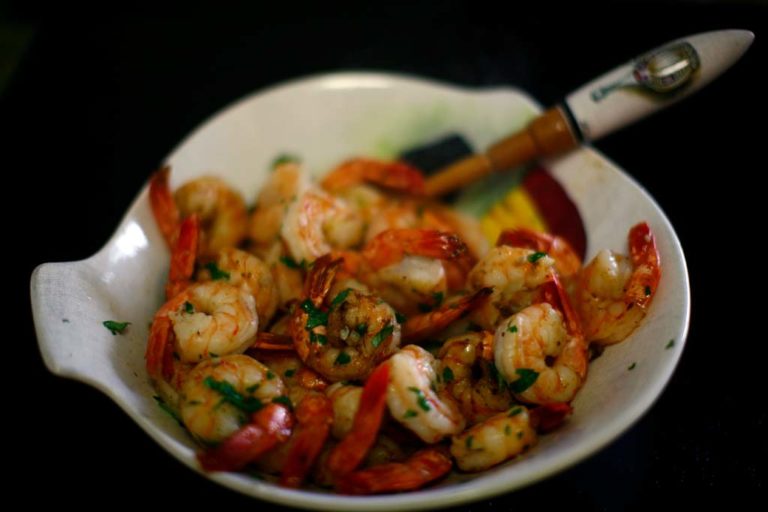
Chef's notes:
The word scampi originally referred to a species of lobster: Nephrops norvegicus, also known as the Norway lobster, Dublin bay lobster, or a langoustine. In America, scampi has become a cooking process instead of a species of lobster. And that is just fine because shrimp scampi is one tasty dish. Usually shrimp scampi is served with bread or over pasta, but it doesn’t have to be. I ate mine out of the bowl, one after another with a simple salad of mixed greens.
The nice thing about working with shrimp is they cook so quickly. So they are a good thing to prepare when you are hungry. And even though working with fresh ingredients is always better, there just aren’t many places you will be able to get fresh shrimp. But, as it turns out, most people can’t tell the difference between fresh and individually quickly frozen (IQF) shrimp. Shrimp also thaws in around ten minutes, which is nice for those quick meals I was talking about earlier.
Ingredients
- 2 pounds peeled and deveined shrimp
- Sea salt
- Black pepper
- Minced parsley
- ½ cup dry white vermouth
- 1 Tbsp lemon juice
- 4 Tbsp butter (or more!)
- 6 minced garlic cloves
Shrimp Recipe: Peeled and Deveined Shrimp Cooked with Vermouth, Lemon, Garlic and Butter
- If you are using frozen shrimp, thaw them first in cool, slow-running water. Shrimp thaws very quickly. For this recipe, I used U 20 shrimp, which means there are around 20 to a pound. I bought them frozen from my local seafood specialty shop. Once the shrimp are thawed, pat them dry with paper towels. Wet shrimp will make the butter spit, which could burn you. Put the dry shrimp into a mixing bowl with a paper towel in the bottom while you get the frying pan ready in the next step.
- Put 2 tablespoons butter into a frying pan and heat it up to one click past medium. Spread the butter around the pan as it melts. Once it starts to foam, quickly lay the shrimp in the pan on their sides as closely together as you can squeeze them. Cook the shrimp for approximately one minute on the first side. Quickly flip them with a pair of tongs to the other side and cook them for one and a half minutes. Take them out of the pan and put them into a bowl. Cook the remaining shrimp in the same fashion.
- Once you finish frying all the shrimp, it's time to make the sauce. Add another tablespoon of butter to that pan and melt it. Once the butter is melted, add the minced garlic and cook until it starts to brown. Next, add the vermouth and lemon juice. Using a spatula, scrape up the bits of stuff stuck to the pan. Cook the liquid until it starts to thicken and look kinda syrupy. Then put the shrimp back in the pan and stir to coat all the shrimp with the sauce. Only leave them in the pan for a couple minutes.
- Shrimp scampi is traditionally served over noodles or with toasted bread. I like linguine noodles because they are a little fatter but narrower than fettuccine noodles. This time I decided to just serve a big bowl of shrimp scampi garnished with minced flat-leaf parsley. The nice thing about shrimp scampi is that you can make it from start to finish in 10 minutes. Even if you are using frozen shrimp, you can still get it done in around 20 minutes. Enjoy this tasty shrimp dish!
Tips & Tricks
- Oftentimes you will see shrimp scampi broiled in butter. This is extremely tasty, but it is not really shrimp scampi. But seeing as today’s shrimp scampi is vastly different from the original dish, I guess it doesn’t really matter. To make the shrimp this way, pan fry the shrimp on one side only. Place the shrimp uncooked side up in a broiling pan of some sort. Bunch them together as tightly as you can, overlapping the tails under the head of the neighboring shrimp. Make the sauce same as before just double the liquids and quadruple the butter. Cook the sauce down a little and pour it over the shrimp. It is best if the shrimp are submerged in sauce. Place the shrimp under a broiler on high and watch them closely. Once the shrimp is red and there is a little caramelization going on, they are done.
- If you want to buy “American” shrimp, stay away from black tiger shrimp, as it is imported.
- Shrimp and prawn are different species but are commonly mislabeled. Prawn are bigger but taste very similar to shrimp.
- Don’t buy precooked shrimp; they will end up overcooked in your dishes.
- P & D means peeled and deveined.
- IQF means Individually Quickly Frozen.
- U 20 means 20 units per pound.
